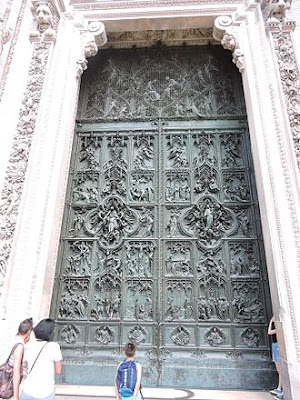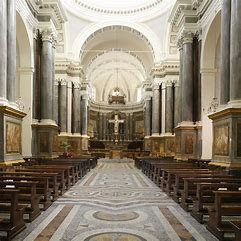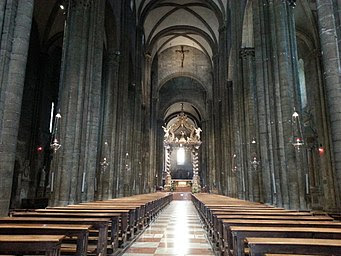Italy-6
I have previously blogged about Italy as follows:- 11-6-2019—Italy 1
- 11-13-2019—Italy 2
- 10-1-2020—Italy 3
- 10-8-2020—Italy 4
- 11-1-2021—Italy 5
Friuli-Venezia Giulia, Trentino-Alto Adige, Valle d’Aosta, Veneto, and parts of Liguria, Lombardy, and Piedmont in northern Italy. The ecclesiastic provinces are Gorizia, Milan, Turin, Trent, Udine, Venice, and Vercelli.
Province of the Patriarchal See of Venice
The Patriarchal See of Venice consists of the Administrative Region of Veneto and the southwestern portion of Friuli-Venezia Giulia. A diocese was created in 774 and that became the Patriarchal See of Venice in 1451. Pope Nicholas V created the Patriarchal See, which is one of only four in the Western Catholic Church, the others being Lisbon, the East Indies, and Jerusalem.The Patriarchal Cathedral Basilica of St. Mark in Venice began construction in the 11th Century initially as a chapel for the Doge, the ruler of Venice. The brick building is of Italo-Byzantine design, although the façade is mostly Gothic. Pope Pius VII declared the Cathedral to be a minor basilica in 1806 and it did not become the Cathedral of the Patriarch until 1807. The Cathedral Basilica contains the earthly remains of St. Mark the Evangelist, which were taken from Alexandria, Egypt, by the Venetians in 828.
St. Mark’s has one large dome and four smaller domes. The 325-foot campanile is a reproduction of the 15th Century structure that collapsed in 1902. The façade features the Horses of St. Mark, which presumably date to the Roman Empire and were taken by the Venetians from Constantinople in 1204 as a result of the Fourth Crusade. The original is now in the church’s museum—the horses displayed above the façade are bronze replicas. The Crusaders also brought back another Roman sculpture referred to as the Four Tetrarchs, which stands above one of the arches of the façade.
St. Mark’s has one large dome and four smaller domes. The 325-foot campanile is a reproduction of the 15th Century structure that collapsed in 1902. The façade features the Horses of St. Mark, which presumably date to the Roman Empire and were taken by the Venetians from Constantinople in 1204 as a result of the Fourth Crusade. The original is now in the church’s museum—the horses displayed above the façade are bronze replicas. The Crusaders also brought back another Roman sculpture referred to as the Four Tetrarchs, which stands above one of the arches of the façade.
The interior has a marble floor and is filled with gold glass mosaics some dating to the 11th Century. The main altar, the Pala d’Oro, is of Byzantine design and incorporates 1,300 pearls, 300 sapphires, 300 emeralds, and 400 garnets. The altar area has bronze statues of the Evangelists and the Four Doctors.
All the pictures are from Wikipedia, except the last two which are from Flickr and Pinterest.
The Co-Cathedral Basilica of St. Peter of Castello in Venice served as the cathedral for the Patriarch of Venice from 1451 to 1807. A church has been on this site since the 7th Century and after an 1120 fire a new building was completed. Once it became the cathedral in 1451, major renovations were undertaken and continued through the 16th Century. The Basilica has a façade designed by Andrea Palladio and features a dome and bell tower. The Renaissance bell tower is made from Istrian stone. The 17th Century main altar is made of inlaid polychrome marble. The Basilica has several works of art including the 13th Century marble Throne of St. Peter, as well as several paintings. The Basilica fell into disrepair after Napoleon designated St. Mark’s to be the Cathedral of the Patriarch and it was further damaged during the First World War. It has since been restored.
The Province has nine suffragan dioceses.
- The Diocese of Belluno-Feltre was established as the Diocese of Belluno in the 2nd Century and acquired its current name in 1986.
- The Diocese of Vicenza was established in the 2nd Century.
- The Diocese of Padova (Padua) was established in the 3rd Century.
- The Diocese of Verona was established in the 3rd Century.
- The Diocese of Concordia-Prodenone was established as the Diocese of Concordia in 380 and acquired its current name in 1971.
- The Diocese of Treviso was established in the 4th Century.
- The Diocese of Vittorio-Veneto was established as the Diocese of Ceneda in the 6th Century and acquired its current name in 1939.
- The Diocese of Chioggia was established in the 7th Century.
- The Diocese of Adria-Rovigo was established as the Diocese of Adria in 640 and acquired its current name in 1986.
Province of Milan
The province consists of most of the Administrative Region of Lombardy. The Diocese of Milan was established in the 1st Century and became a metropolitan archdiocese in 374. About 5 million Catholics in the area near Milan, including part of Switzerland, use the Ambrosian liturgical rite. This rite dates at least to the 8th Century and is named for St. Ambrose, a Fourth Century bishop of Milan.The Cathedral Basilica of the Nativity of the Blessed Virgin Mary in Milan was built between 1386 and 1965. It is the second largest church in Europe with an interior space of more than 125,000 square feet. It is mainly Gothic in design and is built with brick faced with white marble. The decorative façade was completed in 1812 upon orders from Napoleon. The Cathedral’s roof is supported by 52 pillars, each 148 feet high.
The Cathedral contains the tombs of St. Charles Borromeo and Pope Martin V and 3,400 statues, including one of St. Bartholomew flayed alive. The Cathedral also has a nail used in the Crucifixion. The Cathedral was designated a minor basilica by Pope Paul VI in 1964.
The first five pictures are from Wikipedia, the next is from Panaramio, and the last from Pinterest.
The Province has nine suffragan dioceses.
- The Diocese of Brescia was established in the 1st Century.
- The Diocese of Pavia was established in the 1st Century.
- The Diocese of Bergamo was established in the 4th Century.
- The Diocese of Como was established in 4th Century.
- The Diocese of Cremona was established in the 4th Century.
- The Diocese of Lodi was established in the 4th Century.
- The Diocese of Mantova was established in 804.
- The Diocese of Vigevano was established in 1530.
- The Diocese of Crema was established in 1579.
Province of Turin
The province consists of the Administrative Region of Valle d’Aosta, most of Piedmont, and part of Liguria. The Diocese of Turin was established in the 4th Century and became a metropolitan archdiocese in 1515.The Cathedral of St. John the Baptist in Turin was built between 1491 and 1498, and the brick bell tower was built in 1470. The Chapel of the Holy Shroud, designed by Guarino Guarini in a Baroque style, was added in the late 17th Century, to house the Shroud of Turin. This chapel is one of a dozen. The dome was also added in the 17th Century. The Cathedral is also the burial site of Blessed Pier Giorgio Frassati (1901-1925), who was beatified in 1990 and has been called the “saint for youth of the Third Millennium.”
All pictures are from Wikipedia
The Province has 10 suffragan dioceses.
- The Diocese of Asti was established in the 3rd Century.
- The Diocese of Acqui was established in 4th Century.
- The Diocese of Alba was established in the 4th Century, was suppressed in 1803, and restored in 1817.
- The Diocese of Aosta was established in the 4th Century, was suppressed in 1803, and restored in 1817.
- The Diocese of Ivrea was established in the 5th Century.
- The Diocese of Mondovi was established in 1388.
- The Diocese of Saluzzo was established in 1511.
- The Diocese of Pinerolo was established in 1748, was suppressed in 1803, and restored in 1817.
- The Diocese of Susa was established as a territorial abbacy in 1200, became a diocese in 1772, was suppressed in 1803, and restored in 1817.
- The Diocese of Cuneo-Fossano was established in 2023 as a merger of two dioceses.
Province of Gorizia
The province consists of the southeastern portion of the Administrative Region of Friuli-Venezia Giulia. The Metropolitan Archdiocese of Gorizia was established in 1751, was suppressed in 1788, restored as a diocese in 1797, and restored as a metropolitan archdiocese in 1830.The Cathedral of Saints Hilarius and Tatianus in Gorizia dates at least to the 13th Century. It was enlarged by 1525 and redesigned in a Gothic fashion. Two hundred years later, the Cathedral was refurbished in a Baroque style. The Neo-classical façade was added in the 19th Century. The Cathedral was heavily damaged during the First World War but has been restored. The Cathedral has many artworks. The 16th Century St. Acathius’ Chapel is particularly noteworthy with depictions of angels as musicians.
All pictures are from Wikipedia.
The Province has one suffragan diocese.
- The Diocese of Trieste was established in 542.
Province of Udine
The province consists of the central and northern portions of the Administrative Region of Friuli-Venezia Giulia. The Metropolitan Archdiocese of Udine was established in 1751, was demoted to a diocese in 1818, before being restored to a metropolitan archdiocese in 1847.The Cathedral of the Assumption of the Blessed Virgin Mary in Udine was completed in the 14th Century, but received a major restoration in the 18th Century. The Cathedral has a Romanesque-Gothic exterior with a Baroque interior. The two main doors were created by German artists in the 14th Century and feature scenes from the life of Jesus and the saints. There are many works of art inside. The bell tower has a chapel with 14th Century frescoes.
The first four pictures are from Wikipedia, the fifth is from Pinterest, and the sixth from a local website.
The Province has no suffragan dioceses.
Province of Vercelli
The province consists of the northeastern portion of the Administrative Region of Piedmont. The Diocese of Vercelli was established in the 3rd Century and became a metropolitan archdiocese in 1817.The Cathedral Basilica of St. Eusebius in Vercelli is dedicated to its first bishop. Construction of the current building began in the late 16th Century and continued into the 18th Century. The campanile was built in the 12th Century and the dome was added in the late 19th Century. Pope Gregory XVI declared it a minor basilica in 1834.
The first four pictures are from Wikipedia and the last two are from Pinterest.
The Province has four suffragan dioceses.
- The Diocese of Novara was established in the 4th Century.
- The Diocese of Alessandria was established in 1175, was suppressed in 1803, and restored in 1817.
- The Diocese of Casale Monferrato was established in 1474.
- The Diocese of Biella was established in 1772, was suppressed in 1803, and restored in 1817.
Province of Trent
The province consists of the Administrative Region of Trentino-Alto Adige. The Diocese of Trent was created in the 2nd Century, became an archdiocese in 1929 and a metropolitan archdiocese in 1964.The Cathedral Basilica of St. Vigilius in Trent is named for the first Bishop of Trent. The current Romanesque Cathedral was built between 1212 and 1743 on the site of a 4th Century church. The Gothic south façade was added in the early 14th Century along with the rose window depicting the Wheel of Fortune with Christ at its center. The transept is decorated with 14th Century frescoes.
The Cathedral hosted two significant events in the 16th Century: the coronation of Maximilian I as Holy Roman Emperor in 1508 and the Council of Trent between 1545 and 1563. The decrees of the Council were proclaimed before a statue of Christ that is now in the Chapel of the Crucifix. Pope Pius X declared the Cathedral to be a minor basilica in 1913.
The Province has one suffragan diocese.
- The Diocese of Bolzano-Bressanone was established in the 6th Century and acquired its current name in 1964.
Definitions
The Catholic Church is mostly divided into ecclesiastical provinces—a province consists of a metropolitan archdiocese and one or more dioceses. The province and the archdiocese are led by an archbishop. Each of the dioceses is called a suffragan diocese and is led by a bishop. Archbishops have some responsibilities for the province, but all bishops answer directly to the Pope.A basilica is an honorary title bestowed on a church by the Pope because of the church’s antiquity, dignity, historical importance, or significance as a center of worship. Some cathedrals are also basilicas. Each basilica has a ceremonial umbrella in the papal colors of white and yellow and a ceremonial bell. Both of these are symbolic of the Pope’s special relationship to the basilica.























































